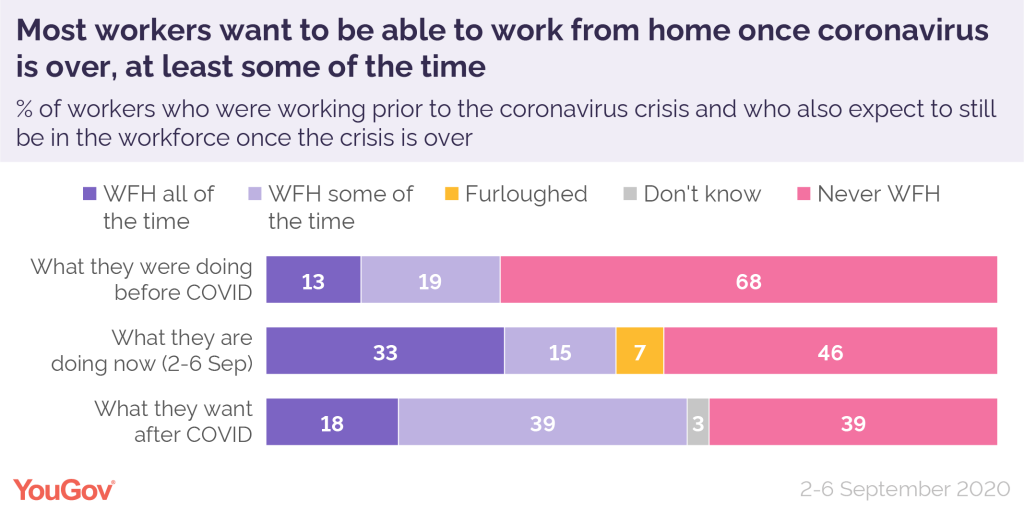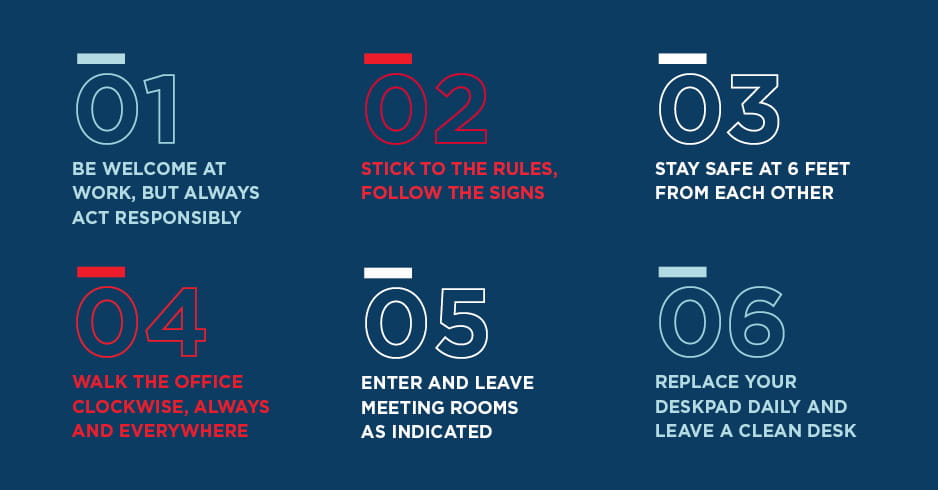The future of remote working
A New Challenge for Internal Comms
About the author
Christine Virginie prepared this article for a CIPR Professional PR Diploma assignment while studying with PR Academy.


On March 31st 2020, Microsoft recorded 2.7 billion meeting minutes experienced in Teams, an incredible 200% increase since March 16th in the same year.
Tower Hamlets Council purchased 2,063 devices since the coronavirus pandemic hit. This evidence suggests remote working is potentially here to stay.
However, as Peter Crush from Raconteur questions: ‘are councils and many other employers actually firing the starting pistol for a potential future problem, eroding the very essence of what it is to actually feel employed?’
What will futurology determine about working conditions and what are the knock-on effects to internal communications? We explore the potential and the considerations internal comms (IC) specialists must make if they are to play a part in the survival of their organisation.
The Ever Evolving Work Place
Is change something to be afraid of? What we need to remember here is that change is not something new, it might be accelerated or in fact forced during these times, but it is not new. A long history of innovation exists in which opportunities to create better futures have been taken and prevailed. The UK is well into its fourth industrial revolution, with the potential impact to improve working practice through AI and automation allowing smart choices to be made faster than ever before.
Another, and unexpected force of change has been the global pandemic, which has caused a rise of remote working with many organisations considering this way of working as the new normal, post-Covid. Whether this is a force for good or for bad has yet to be determined. Either way, change should be considered an opportunity to innovate so that society emerges in a stronger position.
Why are big tech companies like Facebook and Twitter saying their employees can now work from home forever, rather than just a temporary measure? Even funding staff with the necessary tools. For Facebook, embracing remote working will enable the geographic diversification from its home in Silicon Valley. Founder Mark Zuckerberg claims that over the next 5 to 10 years, they aim to have half of their 48,000 employees in 70 offices worldwide working remotely. There are plans to build three new ‘hubs’ in which workers could occasionally meet.
What are the reasons for the shift in attitude? Remote working certainly came with its sceptics, with the long tradition of the insistence of ‘presenteeism’ and the perception that if your staff can be seen, they are working. Sending everyone home meant leaders had no choice but to trust their people. It would seem this trust has not been misplaced. Since this shift to homeworking, numerous surveys have revealed increased productivity, with one Californian based company tracking a 47% increase in worker productivity. Could an increase of productivity be attributed to the social exchange theory, based on the idea that both parties abide by rules and norms of exchange that generate reciprocity.
So, in exchange for the opportunity to choose where one works and benefit from increased personal freedom, workers will be prepared to make sacrifices such as unpaid work or work harder to get noticed. There are however, disadvantageous commonalities emerging, such as the difficulty in separating home life with professional, the social isolation and the risk of losing professional contacts. For many, these might outweigh the positives.
What Is The Future Of Remote Working?
The big evolutionary question; will the physical office be a remnant of the past? Will workers want to continue working from home? A Microsoft survey revealed that 82% of managers expect to have more flexible work from home policies post-pandemic. 71% of employees surveyed would like to continue working from home, at least part-time. For some, remote working was viewed as a temporary measure until office working can resume. One Harris poll found that only 35% of respondents have a dedicated home office and only 5% lived alone. These stats back up the notion that distractions, connection issues and the lack of ergonomic work environments have been common themes in the pain points of remote working.
“When working from home, I’m sitting at the dining room table. At the office, I could have a keyboard and two screens and a comfortable chair.” – Information Worker
Not to mention the social connection, team bonding and mental health implications of working in one’s own company for great periods of time. A Guardian article reported on an incident of a 23 year old who landed a marketing job with an online education company based in the Middle East. Living in a small house, in a small town, she initially thought working from home would be great. However, after four months of long days alone at the tiny desk in her bedroom, she had a panic attack. She had also lost weight and become depressed. “At first, I thought it was because the job was demanding, but I realised it was more the isolation and not being able to interact with people,” she says. “I hadn’t realised I’d relied on that so heavily for my mental health.”
Despite all this talk of improved productivity from remote working, how sustainable is this? A London based solicitors, JMW, brought 40% of its office staff back and said it helped with productivity. Lee Adams, a partner in the firm, said: “The number of ideas that come out when you have people collaboratively working in the same space are just much more tangible than perhaps emails flying around or zoom calls that are a bit more stilted.”
Horizon Scanning
Over the next 0–3 years, it’s certainly looking like there will be hybrid working choices, which will foster win-win situations for both employer and employees. Figure 1 shows 57% would like the option to still work from home. Then there is the flip side that some employees will just not want to work from home.

Perhaps some are concerned about the safety aspect of the office environment. To overcome the social distancing fears, Cushman & Wakefield introduce the 6 Feet office, a conceptual idea to normalise the distancing rule, see figure 2. Their belief is workers can maintain social distancing while still creating an effective workplace. Considerations like this will become the norm in office design.

Office and wearable technology will continue to grow in an innovative fashion. UBM’s award-winning headquarters has become a beacon of best practice, with smartcard desk booking systems and plethora of ‘intelligent’ systems that will predict and operate autonomously. These advances will be one of the driving forces in the reason we go to the office. According to Gensler, employees want to be connected emotionally. Going into the office will be a place you want to visit to be as much about tech disconnection as connectivity, for a space to think and nurture emotional connection.
Challenges Ahead For Internal Comms
Traditional IC used to be about communicating with all employees in one place, working the 9-5 pattern, with methods such as ‘Town Halls’ and newsletters. Using the basic form of communication between sender and receiver. Then came a seismic shift, Justin Harling, CEO of CAE Technology said: ‘Coronavirus meant that we (CAE) went from having eight company offices to 300 home offices – overnight’. In its present-day form, IC is very virtual focussed in terms of daily check ins, team building, audience segmentation and in some cases, furlough comms.
IC used to be regarded as an afterthought once budget was allocated to external comms and PR. Now we find ourselves in an era in which IC is seen as a critical function, which, without successful execution, could be the cause of a demise of the organisations.
Why Has IC Been Catapulted Into The Limelight?
The COVID situation has certainly raised the profile of IC. While IC still needs to achieve its bread and butter functions of keeping employees engaged and motivated. It has never been more crucial for everyone to know what is going on and that they are not on their own. Without this torch light of knowledge, uncertainty creeps in, people become nervous and the sense of togetherness will disappear. If this situation unfolds, how can any organisation move forward and continue to achieve its objectives. The workplace just brings about matters for consideration, perhaps not so prevalent before.
What Are The New Issues?
The current climate presents new challenges the IC team will encounter. Each element needs to be addressed to develop a successful IC strategy.
The Fragmented Work Place
With the future looking like a blended way of working, employees will no longer be in one place, for example, one team may decide to hire shared offices in one town for their team meets, while another may decide to conduct their team meeting using Zoom. With the workforce dispersed, there is not one physical space to exchange information.
Random Hours Of Work
Microsoft’s Work Trend Index tracked a change in the average number of Microsoft Team chats, which suggests the end of the traditional 9–5 day. Employees will find the flexibility to work around their lifestyles to enable a good work life balance and get to see their children grow up, instead of missing out on major child developmental milestones by spending long hours at the office.
Technological Advances
There are now so many different methods to send and receive information. Long gone are the days of the office notice board. There is the option to email, create podcasts, communication apps and more sophisticated intranets. While having numerous options is novel, there is still the question of which ones will be most successful in conveying the message. As these technologies come with a price tag, they cannot just be implemented without some form of prior analysis.
What Are The Key IC Considerations For Successful Execution?
There are some key ideals which would be explored whether COVID happened or not. As basic principles are ever present and as discussed earlier, change is not a new thing. However, this wisdom about IC is echoed from comms professionals worldwide, perhaps just that little bit louder at the moment.
How many of you really understand ‘the why’ of your internal comms campaign…what is the problem you are trying to solve? Is it to unite the workforce or communicate the new strategy? Before the knee jerk reaction of jumping into tactics, really understand the why. Once you’ve established this, you can move onto the how and what. Knowing those elements will inform your channel choices and how you integrate them. Just randomly introducing various methods could become messy with the likelihood to fail, not to mention the cost implications. Imagine embracing the next generation tech to develop lifelike avatars to share information in a hologram, but the key message not established or tailored.
Treat IC as you would external comms, get to know your workforce; not everyone is the same. Target your communications accordingly. For example, are you talking to employees with children at home, or someone living alone? Both will have very different experiences and needs.
Actively encourage engagement and create the opportunity for two-way comms. Gone are the days of the message and the receiver. Create the art of meaningful conversation, use techniques that build connection, belonging and trust. Perhaps the use of the nudge theory to encourage engagement by the addition of a fun element, which is the easiest way to change people’s behaviour for the better. Go a step further perhaps, with the introduction of gamification.
Finally, set some metrics. Otherwise how will you monitor and evaluate? How will you demonstrate that the increased engagement, fostered by the IC campaign, led to the increased productivity and retention?
A beautifully illustrated example of treating IC with the importance and respect it deserves, was the award winning, Make Today Great campaign by Anglian Water. The campaign demonstrated how to execute a transformative strategy and internal engagement. The communications plan ensured that every one of its 5,000 employees, including those in non-customer facing roles, viewed customer experience as part of their job.
Centre Stage Illumination
In conclusion, the world of how we work has certainly entered an accelerated evolution caused by COVID. While there does seem to be an indication that remote working is here to stay in some shape or form, evidence would suggest that the longer term negative effects are on the horizon. Be conscious that the cracks in the woodwork will eventually sink the ship. Embrace a hybrid way of working, a mix of home and office work seems the most logical approach, creating a win-win for both employee and employer.
Since the start of COVID, IC has really shot into the forefront of every savvy CEO, creating a space for it on the Board. IC teams must grab this opportunity to revel further by practising and developing resilient issues management plans to account for the changes in this new fragmented workforce. This is the platform IC has been waiting for, to push its presence into centre stage illumination.


